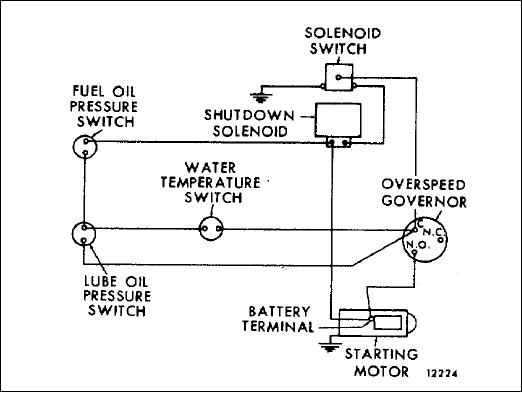
TM 5-3820-245-14&P
AUTOMATIC ELECTRICAL SHUTDOWN SYSTEM
The automatic electrical shutdown system shown in Fig.3 protects the engine against a loss of coolant, overheating of the
coolant, loss of oil pressure, or over speeding. In the event one of the foregoing conditions arises, a switch will close the
electrical circuit and energize the solenoid switch, causing the shutdown solenoid to release the air shutdown latch and
stop the engine.
Operation
The electrical circuit is de-energized under normal operation conditions. When the engine is started, the oil pressure
switch opens when the oil pressure reaches approximately 10 psi (69 kPa) and the fuel oil pressure switch closes at
approximately 20 psi (138 kPa) fuel pressure. The water temperature switch remains open.
If the oil pressure drops below 10 psi (69 kPa), the oil pressure switch will close the circuit and energize the shutdown
solenoid. This will activate the shutdown mechanism and stop the engine.
A loss of coolant or an increase in coolant temperature to approximately 203F (95C) will close the contacts in the water
temperature switch, thus closing the electrical circuit and activating the shutdown mechanism.
The water temperature switch consists of a temperature-sensing valve and a microswitch. The valve contacts a copper
plug (heat probe) which extends into the exhaust manifold outlet. Engine water is directed over the power element of the
valve and should the water temperature exceed approximately 203F (95C), the valve will close the contacts in the micro-
switch and energize the shutdown circuit. If a loss of water occurs, the heat of the exhaust gases will be transmitted
through the copper plug to the temperature-sensing valve and cause the shutdown circuit to be activated.
Figure 7-14 - Automatic Electrical Shutdown System Diagram
PAGE 135

